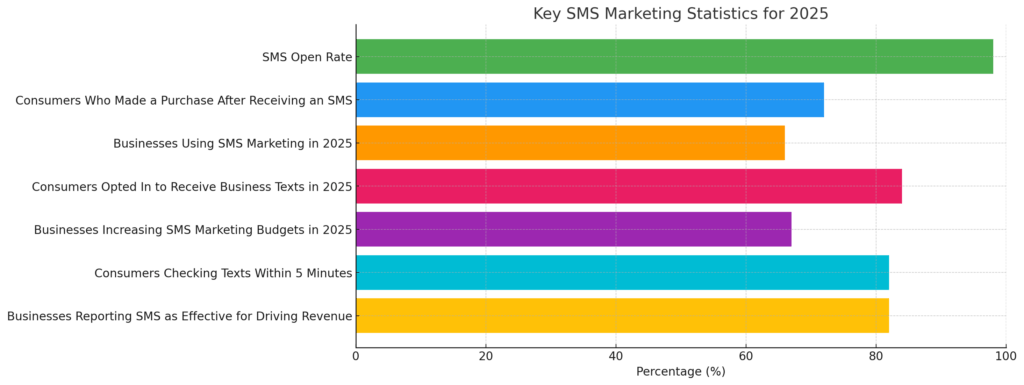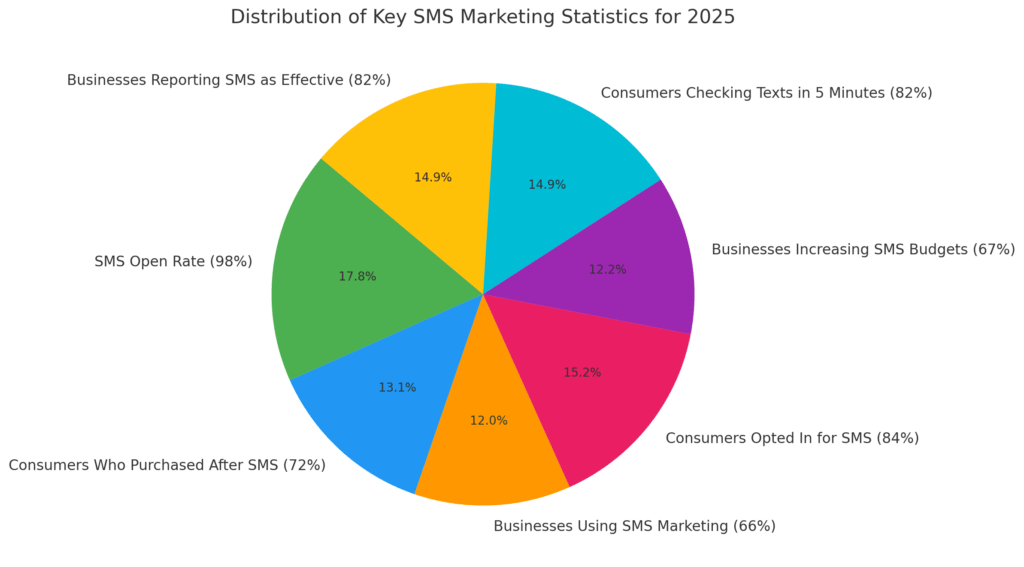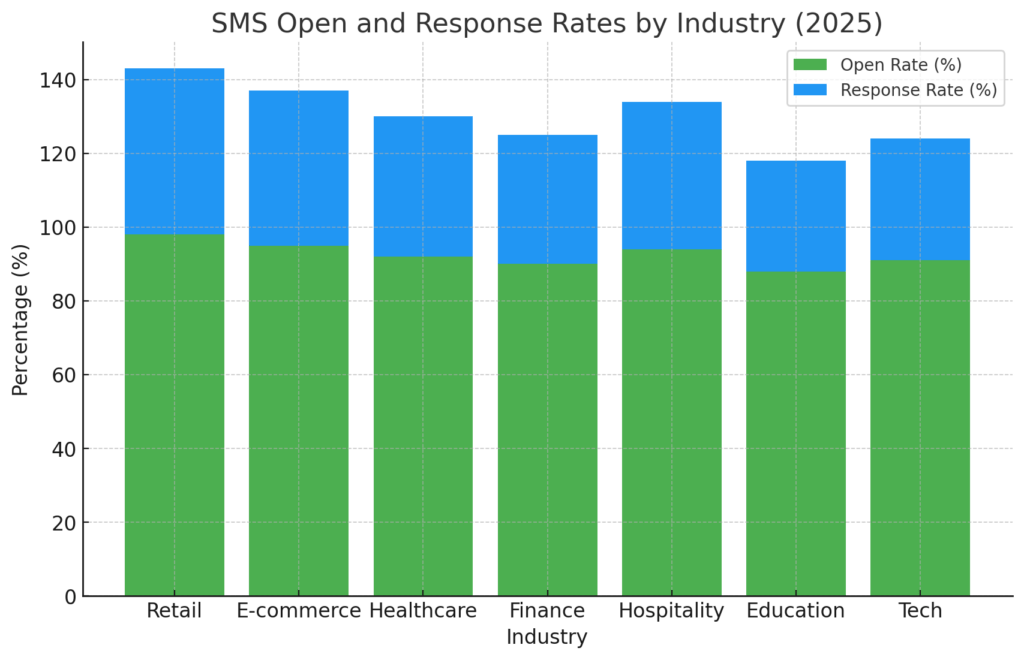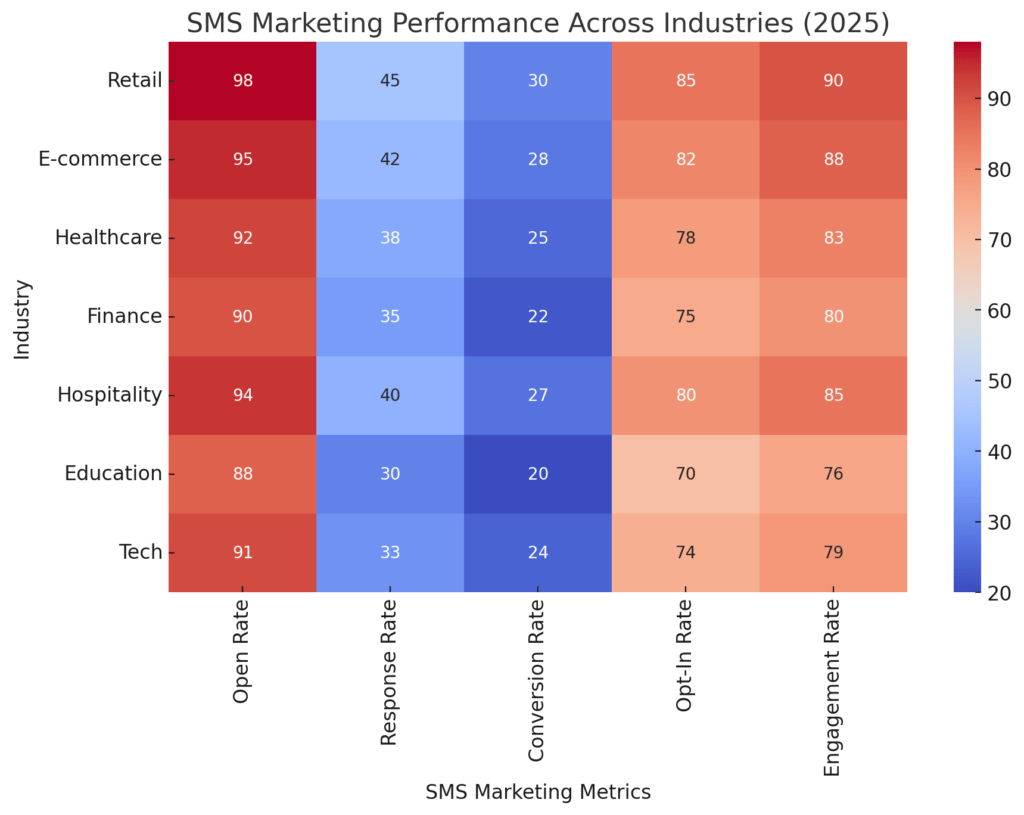
16 Mar BEST SMS MARKETING STATISTICS 2025
SMS marketing has become one of the most effective ways for businesses to engage with consumers, boasting unmatched open rates, rapid response times, and high conversion potential. As mobile usage continues to rise, brands are investing more in text-based campaigns to reach customers directly and drive sales. The growing role of AI, automation, and personalization is shaping the future of SMS marketing, making it an even more powerful tool for businesses looking to enhance customer relationships. However, as adoption increases, companies must strike the right balance between engagement and overuse to maintain consumer trust. With emerging technologies like Rich Communication Services (RCS) and AI-driven message optimization, SMS marketing is evolving into a more interactive and personalized experience. Amra and Elma presents 20 key SMS marketing statistics that highlight its effectiveness over time and provide insights into where the industry is headed in 2025 and beyond.
BEST SMS MARKETING STATISTICS 2025 (Editor’s Choice)
SMS marketing continues to be a powerful tool for businesses, offering unparalleled engagement and conversion rates. Here are 20 of the most compelling SMS marketing statistics, reflecting both historical trends and projections for 2025:
1. High Open Rates: SMS messages boast an open rate of 98%, significantly higher than email’s average of 20%.
2. Rapid Engagement: Approximately 90% of SMS messages are read within three minutes of delivery.
3. Consumer Preference: 75% of consumers prefer to receive promotional content via SMS over other marketing methods.
4. High Response Rates: SMS messages have a response rate of 45%, compared to email’s 6%.
5. Conversion Rates: The average conversion rate for SMS marketing messages is between 21% and 30%, up to ten times higher than email marketing conversion rates.
6. Business Adoption: As of 2025, 66% of businesses use SMS marketing software to communicate with their customers.
7. Budget Increases: 67% of businesses are increasing their SMS marketing budgets in 2025.
8. Revenue Contribution: Businesses report that 11-20% of their revenue can be attributed to SMS marketing.
9. Market Growth: The U.S. SMS marketing market is projected to be worth $12.6 billion by 2025, with a compound annual growth rate of 20.3%.
10. Global Reach: Globally, the number of people who send and receive text messages is predicted to rise to 5.9 billion by 2025.
11. Customer Engagement: 82% of businesses agree that SMS marketing is an effective way to drive revenue.
12. AI Integration: 81% of businesses say AI has improved their SMS marketing success, with most saving 4-6 hours per week on average.
13. Opt-In Rates: 84% of consumers are opted in to receive texts from businesses in 2025, indicating a 6% growth from the previous year.
14. Click-Through Rates: Most businesses report an average SMS marketing click-through rate between 21% and 35%.
15. Consumer Behavior: 93% of consumers text every day, and nearly half (45%) check their text messages more than 10 times a day.
16. Immediate Attention: 82% of consumers check their text notifications within just five minutes of receiving a text.
17. Preferred Communication Channel: 52% of customers prefer SMS as a communication channel.
18. Purchase Influence: 72% of people have made a purchase after receiving a text from a brand.
19. Multiple Purchases: 86% of respondents made two or more purchases in the last year from SMS messages, up from 55% in 2022.
20. Time to Purchase: 65% of people who made an SMS purchase in the last year said it was something they were planning to buy in the near future or in a few months, and they ended up buying the item earlier than planned because of a promotional text message.
These statistics underscore the effectiveness and growing importance of SMS marketing in engaging consumers and driving business success.

BEST SMS MARKETING STATISTICS 2025 and Future Implications
BEST SMS MARKETING STATISTICS 2025 #1. High Open Rates (98%)
The fact that SMS messages have a staggering 98% open rate highlights their dominance over other digital communication channels. Unlike email, where promotional messages often get lost in spam or ignored, SMS ensures visibility. This means businesses can count on near-instant engagement when sending time-sensitive promotions, appointment reminders, or urgent notifications. As AI-driven automation improves, brands can further personalize messages, leading to even higher engagement rates. The challenge moving forward will be maintaining this effectiveness while preventing oversaturation, which could lead to consumers opting out. With SMS gaining traction across industries, companies that integrate it with omnichannel marketing will see higher retention rates. Future advancements in RCS (Rich Communication Services) may also enhance SMS with multimedia, further improving open rates.
BEST SMS MARKETING STATISTICS 2025 #2. Rapid Engagement (90% Read in 3 Minutes)
The immediacy of SMS engagement, with 90% of messages read within three minutes, makes it the go-to tool for urgent communications. Businesses in retail, healthcare, and finance already rely on it for flash sales, appointment confirmations, and fraud alerts. This trend suggests that SMS will remain a dominant force in real-time marketing, where timing is everything. As mobile dependency grows, we can expect increased investment in SMS-based customer service, reducing reliance on traditional call centers. AI-powered chatbots integrated with SMS will further enhance this speed, providing automated yet personalized interactions. However, brands must be cautious not to overwhelm users with frequent texts, as this could lead to fatigue. The next evolution could involve AI predicting optimal send times to maximize response rates.
BEST SMS MARKETING STATISTICS 2025 #3. Consumer Preference (75% Prefer SMS for Promotions)
With 75% of consumers preferring SMS for promotions, businesses have a golden opportunity to connect with their audience in a way that feels less intrusive than emails or phone calls. This preference underscores a shift toward mobile-first marketing strategies that prioritize direct, concise messaging. Companies that personalize offers based on past purchases or browsing history will see even better results. As SMS marketing tools integrate more AI-powered personalization, response rates are expected to increase. However, brands must maintain a balance, ensuring they provide value rather than flooding users with messages. The future of SMS promotions may include interactive elements such as click-to-purchase links, AI-driven recommendations, and RCS-enhanced visuals. Businesses that capitalize on these features will set themselves apart in an increasingly competitive mobile marketing landscape.
BEST SMS MARKETING STATISTICS 2025 #4. High Response Rates (45% Compared to Email’s 6%)
A 45% response rate for SMS compared to just 6% for email underscores how much more effective text messaging is for direct engagement. This higher level of interaction suggests that consumers view SMS as a more personal and immediate form of communication. As businesses move toward conversational marketing, two-way SMS interactions will likely become more common, enhancing customer experience and satisfaction. The rise of AI chatbots within SMS marketing means that brands can automate responses without losing the personal touch. Moving forward, we can expect brands to shift more of their outreach efforts to SMS, reducing reliance on email while integrating messaging with other channels. The challenge will be maintaining engagement without becoming intrusive, requiring brands to refine their segmentation strategies. AI-driven automation will be key in ensuring SMS remains a valuable, high-engagement platform.
BEST SMS MARKETING STATISTICS 2025 #5. Conversion Rates (21-30%)
With SMS conversion rates as high as 30%, brands are increasingly recognizing the potential of text-based campaigns for driving sales. This level of effectiveness means businesses can see a significant return on investment when using SMS for abandoned cart reminders, limited-time offers, and personalized promotions. As AI advances, predictive analytics will allow brands to target users with even more relevant messages, boosting conversions further. The seamless integration of SMS with mobile payment options could also enhance instant purchasing decisions. However, brands must ensure that they are respecting user preferences and not bombarding them with excessive promotions. The future of SMS marketing will likely involve more dynamic messaging, including interactive links, product recommendations, and even augmented reality experiences. Those who innovate in this space will outperform competitors who rely solely on traditional digital marketing tactics.

BEST SMS MARKETING STATISTICS 2025 #6. Business Adoption (66% of Businesses Use SMS Marketing in 2025)
The fact that 66% of businesses will use SMS marketing in 2025 indicates a broader shift toward mobile-first communication strategies. As companies embrace digital transformation, SMS is becoming a key pillar in customer engagement. Industries such as retail, hospitality, and healthcare have already integrated SMS extensively, but the trend is expanding into finance, education, and even government services. With more businesses entering the SMS space, competition for consumer attention will intensify, requiring brands to innovate with more personalized and valuable content. AI-driven automation will help businesses manage large-scale SMS campaigns without losing the human touch. Additionally, compliance with regulations like GDPR and TCPA will remain crucial as SMS marketing expands. Companies that prioritize transparency and user consent will build stronger, long-term customer relationships.
BEST SMS MARKETING STATISTICS 2025 #7. Budget Increases (67% of Businesses Increasing SMS Budgets in 2025)
A 67% increase in SMS marketing budgets reflects growing confidence in its effectiveness. Businesses are reallocating resources from traditional advertising to mobile marketing, where engagement rates are significantly higher. This trend suggests that companies will experiment more with SMS-based loyalty programs, personalized discount offers, and customer service solutions. As AI-driven automation reduces costs while improving targeting accuracy, businesses will see even greater returns on their SMS investments. However, increased spending also means that competition for consumer attention will rise, requiring brands to fine-tune their messaging strategies. Future innovations may include dynamic SMS campaigns that adjust in real time based on user behavior. The brands that successfully leverage these advancements will solidify SMS as a primary driver of customer engagement and sales.
BEST SMS MARKETING STATISTICS 2025 #8. Revenue Contribution (11-20% of Revenue from SMS Marketing)
The fact that SMS marketing contributes up to 20% of total revenue for businesses highlights its effectiveness as a sales channel. This growing revenue share suggests that SMS is not just a complementary tool but a core component of modern marketing strategies. As more brands integrate SMS with e-commerce platforms, expect to see an increase in direct-to-consumer sales through text-based promotions. Subscription-based businesses are also benefiting from SMS renewals and re-engagement campaigns. AI-powered predictive analytics will further refine targeting, ensuring messages reach the right customers at the right time. However, overuse could lead to opt-outs, so brands must balance frequency with value. Moving forward, SMS marketing will likely become more interactive, integrating voice search and AI-powered chat to drive higher conversions.
BEST SMS MARKETING STATISTICS 2025 #9. Market Growth ($12.6 Billion U.S. Market by 2025)
With the U.S. SMS marketing industry projected to hit $12.6 billion in 2025, the sector is poised for significant expansion. This growth is fueled by increasing mobile phone usage, AI-driven automation, and a shift toward mobile-first marketing. More businesses are recognizing the value of SMS for personalized, direct engagement, which explains the rapid adoption. However, with growth comes regulatory challenges, requiring brands to ensure compliance with consumer protection laws. Innovations such as RCS messaging, which enables multimedia content in texts, could further boost industry value. Companies that embrace AI-driven segmentation and automation will lead in this growing market. As SMS evolves, expect more integration with voice search and chatbot technologies, making text-based marketing even more interactive.
BEST SMS MARKETING STATISTICS 2025 #10. Global Reach (5.9 Billion SMS Users by 2025)
The global rise to 5.9 billion SMS users highlights the universality of text messaging as a communication tool. This statistic suggests that SMS remains relevant despite advancements in app-based messaging services. Emerging markets, where internet access may be limited, continue to rely on SMS, making it a crucial channel for global brands. As AI-powered localization improves, businesses can better tailor SMS campaigns to different cultural and linguistic demographics. The challenge will be ensuring personalization at scale, as generic messages are less likely to engage users. In the future, SMS marketing may become even more interactive, incorporating chatbots, voice recognition, and RCS enhancements. Companies that leverage this technology will maintain a competitive advantage in an increasingly mobile-centric world.

BEST SMS MARKETING STATISTICS 2025 #11. Customer Engagement (82% of Businesses Say SMS Drives Revenue)
With 82% of businesses agreeing that SMS marketing effectively drives revenue, it’s clear that this channel is not just about communication but also direct sales. The immediacy of SMS means businesses can see near-instant results from promotional messages, limited-time offers, and abandoned cart reminders. As AI advances, expect predictive analytics to refine SMS targeting, allowing businesses to send hyper-personalized recommendations. This will be especially useful in e-commerce, where personalized discounts and loyalty rewards can significantly impact conversion rates. However, brands must be careful not to overuse SMS, as excessive messaging could lead to higher opt-out rates. To maintain engagement, companies will need to focus on delivering value through exclusive offers, VIP experiences, and two-way customer interactions. Moving forward, SMS is likely to become even more interactive, incorporating AI-driven responses and dynamic content.
BEST SMS MARKETING STATISTICS 2025 #12. AI Integration (81% of Businesses Say AI Enhances SMS Marketing)
The fact that 81% of businesses report improved SMS success through AI demonstrates the growing role of automation in text marketing. AI-driven tools help brands optimize message timing, personalize content, and automate customer responses without losing authenticity. This reduces manual workload while improving efficiency, making SMS marketing more scalable for businesses of all sizes. In 2025, we can expect AI to further refine SMS strategies, using predictive analytics to send messages at the perfect moment based on past behavior. AI-powered chatbots within SMS will also enhance customer service, allowing for automated yet natural conversations. As machine learning advances, SMS marketing will become more intuitive, delivering hyper-relevant content without feeling intrusive. Companies that integrate AI seamlessly into their SMS campaigns will maintain a competitive edge in a crowded digital space.
BEST SMS MARKETING STATISTICS 2025 #13. Opt-In Rates (84% of Consumers Opted In for SMS in 2025)
With 84% of consumers opting in to receive SMS from brands, trust in text-based marketing is clearly strong. This high opt-in rate suggests that consumers see value in SMS communications, whether for promotions, order updates, or customer service. However, with more brands using SMS, competition for consumer attention will increase, requiring businesses to focus on delivering high-quality content. AI-driven personalization will be crucial in ensuring that messages remain relevant and engaging rather than feeling spammy. Additionally, brands will need to navigate privacy regulations carefully, ensuring compliance with opt-in and data protection laws. As SMS marketing continues to evolve, brands that maintain transparency and provide clear value will retain high opt-in rates. Future advancements, such as interactive text-based surveys or personalized QR codes, could further enhance engagement.
BEST SMS MARKETING STATISTICS 2025 #14. Click-Through Rates (21-35%)
An SMS click-through rate of 21-35% highlights the effectiveness of text-based marketing for driving direct actions. Compared to email and social media, where engagement can be diluted, SMS offers a more direct and focused way to encourage conversions. This suggests that businesses can significantly boost sales by incorporating SMS into their marketing mix, particularly for time-sensitive offers. AI-powered message personalization will further improve click-through rates, ensuring recipients receive relevant promotions tailored to their interests. However, businesses must strike a balance between frequency and value, as sending too many messages could reduce engagement over time. Looking ahead, SMS could become even more interactive, integrating AI-powered product recommendations and one-click purchasing options. Companies that leverage these innovations will maximize the effectiveness of their SMS campaigns.
BEST SMS MARKETING STATISTICS 2025 #15. Consumer Behavior (93% of Consumers Text Daily, 45% Check Messages 10+ Times a Day)
With 93% of consumers texting daily and nearly half checking their messages more than 10 times a day, SMS remains one of the most frequently used communication channels. This behavior presents a massive opportunity for businesses to connect with consumers at a moment’s notice. Given that people are already accustomed to engaging with texts, brands that craft engaging, relevant messages will see higher response rates. However, there’s also a risk of fatigue if consumers feel overwhelmed by frequent marketing messages. To maintain effectiveness, businesses should focus on personalization, exclusivity, and providing real value rather than mass messaging. AI and machine learning will play a crucial role in optimizing the frequency and content of SMS campaigns. Future trends may include voice-activated SMS responses and AI-driven recommendations tailored to a user’s real-time preferences.

BEST SMS MARKETING STATISTICS 2025 #16. Immediate Attention (82% of Consumers Check SMS Within 5 Minutes)
The fact that 82% of consumers check their SMS notifications within five minutes highlights how powerful text messaging is for real-time engagement. Businesses can use this immediacy for flash sales, appointment confirmations, and urgent service updates with high confidence that the message will be seen. As AI advances, predictive analytics will help optimize send times even further, ensuring messages arrive when recipients are most likely to engage. The challenge for brands will be maintaining relevance—messages must feel timely and useful rather than disruptive. Looking ahead, businesses may incorporate AI-powered scheduling to personalize send times based on individual habits. Additionally, integration with other messaging apps and voice assistants could make SMS even more responsive and interactive. Companies that refine their approach will benefit from higher engagement without overwhelming consumers.
BEST SMS MARKETING STATISTICS 2025 #17. Preferred Communication Channel (52% Prefer SMS Over Other Channels)
With 52% of consumers preferring SMS as a communication channel, businesses must recognize the shift toward mobile-first engagement. This preference indicates that many consumers favor the speed and convenience of SMS over email, phone calls, or even app notifications. As a result, brands should invest more in optimizing their SMS strategies to enhance customer experience. This could include two-way texting for support, automated responses for FAQs, and AI-driven personalization for promotions. However, businesses must be careful not to overuse SMS, as excessive messages could drive opt-outs. Looking ahead, SMS will likely evolve into an even more interactive medium, integrating RCS features like images, buttons, and carousels. Companies that prioritize personalization and user-friendly interactions will maintain strong engagement rates.
BEST SMS MARKETING STATISTICS 2025 #18. Purchase Influence (72% of People Have Made a Purchase After an SMS from a Brand)
The fact that 72% of consumers have made a purchase after receiving an SMS from a brand demonstrates the strong conversion power of text marketing. Unlike email promotions that may go unnoticed, SMS commands immediate attention, leading to faster purchasing decisions. Businesses can maximize this trend by using SMS for abandoned cart reminders, flash sales, and limited-time discounts. As AI-driven personalization improves, brands will be able to tailor offers more precisely, increasing conversion rates further. The future of SMS commerce could include direct in-text payment options, making purchasing even more seamless. However, companies must ensure they don’t overuse promotional texts, as excessive messaging can lead to consumer fatigue. Those that strike the right balance will benefit from a steady stream of mobile-driven sales.
BEST SMS MARKETING STATISTICS 2025 #19. Multiple Purchases (86% Made Two or More Purchases from SMS in the Last Year)
With 86% of consumers making at least two purchases via SMS in the last year, brands have a major opportunity to drive repeat sales. This statistic underscores the importance of retention-focused SMS marketing strategies, such as loyalty rewards, VIP discounts, and exclusive offers. Businesses that use AI-driven segmentation can target past buyers with relevant upsells, increasing customer lifetime value. However, brands must ensure that follow-up messages feel organic and valuable rather than pushy. In the future, SMS-based recommendation engines could suggest products based on previous purchases, making the experience more personalized. Additionally, integration with AR-powered SMS shopping experiences could make mobile commerce even more engaging. Companies that embrace these innovations will see higher retention and customer satisfaction.
BEST SMS MARKETING STATISTICS 2025 #20. Time to Purchase (65% Bought Sooner Due to an SMS Offer)
The fact that 65% of consumers purchased items sooner than planned because of an SMS promotion highlights the persuasive power of text messaging. This suggests that well-timed SMS campaigns can accelerate purchasing decisions, reducing the sales cycle. Businesses can capitalize on this by strategically timing promotions, limited-time offers, and early-access deals via text. AI-driven behavioral analysis will further refine these strategies, ensuring that messages reach consumers at the optimal moment. However, brands must balance urgency with trust—too many “limited-time” messages can feel manipulative. Looking forward, SMS could integrate more deeply with AI-powered shopping assistants, helping users discover relevant deals in real time. Companies that use SMS to enhance customer convenience rather than just push sales will build stronger, long-term relationships.
The Future of SMS Marketing: Personalization, AI, and Consumer Trust
As SMS marketing continues to grow, businesses must adapt to evolving consumer preferences and technological advancements. The high engagement rates, rapid response times, and increasing AI integration make SMS a crucial component of modern marketing strategies. However, as more brands enter the space, maintaining relevance without overwhelming consumers will be key. The future of SMS marketing lies in hyper-personalization, AI-driven automation, and interactive messaging formats like RCS, which will enhance user experiences and drive higher conversions. Companies that focus on providing value, respecting consumer privacy, and optimizing message frequency will see the greatest long-term success. With mobile-first communication now the norm, SMS marketing will remain a dominant force, shaping how brands connect with customers in 2025 and beyond.
Sources:
- https://emarsys.com/learn/blog/sms-marketing-statistics/
- https://emarsys.com/learn/blog/sms-marketing-statistics/
- https://emarsys.com/learn/blog/sms-marketing-statistics/
- https://mailchimp.com/resources/sms-marketing-trends/
- https://www.constantcontact.com/blog/sms-marketing-statistics/
- https://simpletexting.com/blog/2025-texting-and-sms-marketing-statistics/
- https://simpletexting.com/blog/2025-texting-and-sms-marketing-statistics/
- https://simpletexting.com/blog/2024-texting-and-sms-marketing-statistics/
- https://www.smscomparison.com/sms-statistics/
- https://www.drips.com/resources/sms-marketing-and-usage-statistics
- https://simpletexting.com/blog/2025-texting-and-sms-marketing-statistics/
- https://simpletexting.com/blog/2025-texting-and-sms-marketing-statistics/
- https://simpletexting.com/blog/2025-texting-and-sms-marketing-statistics/
- https://simpletexting.com/blog/2025-texting-and-sms-marketing-statistics/
- https://simpletexting.com/blog/2025-texting-and-sms-marketing-statistics/
- https://simpletexting.com/blog/2025-texting-and-sms-marketing-statistics/
- https://www.plivo.com/cx/blog/sms-marketing-statistics/
- https://www.klaviyo.com/blog/sms-stats/
- https://www.klaviyo.com/blog/sms-stats/
- https://www.klaviyo.com/blog/sms-stats/

